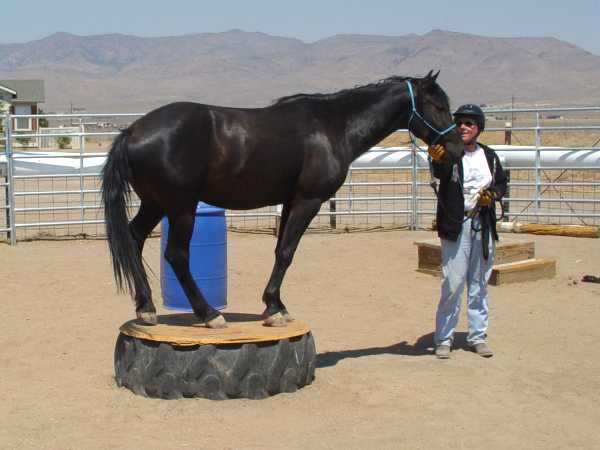Building a "Confidence Course"Part Three
The object is to walk calmly, placing all feet in turn inside the sidewall, then stop with either front or hind feet in the sidewall, and for more advanced horses, back through the sidewall. Walking through the tire sidewall ring.
|
| IN AND OUT ALLEY |
Touching the stop sign on cue.

| ENHANCING THE OBSTACLES |
Also, the obstacles presented in this section are our "permanent" obstacles. We have a number of other interesting obstacles that we can deploy as needed and they can be seen by visiting the links provided below.
| MAKING PROGRESS |
Posing for a photo on the step platform.

Mounting the tire pedestal.

Standing on the tire pedestal.

Here are links to some other obstacle course and bomb proofing ideas.
Building Yourself a Horse Course
Developing Confident Horses
Sharon Beck's Obstacle Courses Made Easy
Wild Horse Boot Camp Obstacles
Bomb Proofing: Producing Horses You Can Trust
Bomb Proofing in Stagecoach
Return to Part Two
Press "Back" to return to the page that brought you here
Go to Case Study Section
Return to Training Section
Return to Wild Horse Mentors
Return to KBR World of Wild Horses and Burros
Go To  KBR Horse Net
KBR Horse Net
Note: When working around any obstacles, you need to pay careful attention to your situation, your horse, any distractions and what others nearby are doing (what impact they may have on you and what impact you may have on them). Some horses may react unpredictably and you need to be prepared to guide them through any situation... or get competent assistance if you are not sure how to do so!
KBR Horse Training Information, © 2007
Lamm's Kickin' Back Ranch and Willis & Sharon Lamm. All rights reserved. Duplication of any of
this material for commercial use is prohibited without express written permission.
This prohibition is not intended to extend to personal non-commercial use, including sharing
with others for safety and learning purposes, provided this copyright notice is
attached.
Email us to submit comments or
request reproduction permission.



